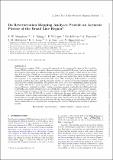Files in this item
Do reverberation mapping analyses provide an accurate picture of the broad line region?
Item metadata
| dc.contributor.author | Mangham, S. W. | |
| dc.contributor.author | Knigge, C. | |
| dc.contributor.author | Williams, P. | |
| dc.contributor.author | Horne, Keith | |
| dc.contributor.author | Pancoast, A. | |
| dc.contributor.author | Matthews, J. H. | |
| dc.contributor.author | Long, K. S. | |
| dc.contributor.author | Sim, S. A. | |
| dc.contributor.author | Higginbottom, N. | |
| dc.date.accessioned | 2019-06-26T14:30:09Z | |
| dc.date.available | 2019-06-26T14:30:09Z | |
| dc.date.issued | 2019-09 | |
| dc.identifier | 259383221 | |
| dc.identifier | ca009caf-9b03-4ac6-8123-912c0b185072 | |
| dc.identifier | 85074616634 | |
| dc.identifier | 000482332500089 | |
| dc.identifier.citation | Mangham , S W , Knigge , C , Williams , P , Horne , K , Pancoast , A , Matthews , J H , Long , K S , Sim , S A & Higginbottom , N 2019 , ' Do reverberation mapping analyses provide an accurate picture of the broad line region? ' , Monthly Notices of the Royal Astronomical Society , vol. 488 , no. 2 , pp. 2780-2799 . https://doi.org/10.1093/mnras/stz1713 | en |
| dc.identifier.issn | 0035-8711 | |
| dc.identifier.uri | https://hdl.handle.net/10023/17972 | |
| dc.description | WM acknowledges the University of Southampton‘s Institute for Complex Systems Simulation and the Engineering and Physical Sciences Research Council for the PhD student that funded his research. CK and NSH acknowledge support by the Science and Technology Facilities Council grant ST/M001326/1. JHM is supported by the Science and Technology Facilities Council under grant ST/N000919/1. KH acknowledges support from STFC grant ST/R000824/1. | en |
| dc.description.abstract | Reverberation mapping (RM) is a powerful approach for determining the nature of the broad-line region (BLR) in active galactic nuclei. However, inferring physical BLR properties from an observed spectroscopic time series is a difficult inverse problem. Here, we present a blind test of two widely used RM methods: MEMEcho (developed by Horne) and CARAMEL (developed by Pancoast and collaborators). The test data are simulated spectroscopic time series that track the Hα emission line response to an empirical continuum light curve. The underlying BLR model is a rotating, biconical accretion disc wind, and the synthetic spectra are generated via self-consistent ionization and radiative transfer simulations. We generate two mock data sets, representing Seyfert galaxies and QSOs. The Seyfert model produces a largely negative response, which neither method can recover. However, both fail “gracefully”, neither generating spurious results. For the QSO model both CARAMEL and expert interpretation of MEMEchoś output both capture the broadly annular, rotation-dominated nature of the line-forming region, though MEMEcho analysis overestimates its size by 50%, but CARAMEL is unable to distinguish between additional inflow and outflow components. Despite fitting individual spectra well, the CARAMEL velocity-delay maps and RMS line profiles are strongly inconsistent with the input data. Finally, since the Hα line-forming region is rotation dominated, neither method recovers the disc wind nature of the underlying BLR model. Thus considerable care is required when interpreting the results of RM analyses in terms of physical models. | |
| dc.format.extent | 4514899 | |
| dc.language.iso | eng | |
| dc.relation.ispartof | Monthly Notices of the Royal Astronomical Society | en |
| dc.subject | Accretion discs | en |
| dc.subject | Radiative transfer | en |
| dc.subject | Quasars: general | en |
| dc.subject | QB Astronomy | en |
| dc.subject | QC Physics | en |
| dc.subject | NDAS | en |
| dc.subject.lcc | QB | en |
| dc.subject.lcc | QC | en |
| dc.title | Do reverberation mapping analyses provide an accurate picture of the broad line region? | en |
| dc.type | Journal article | en |
| dc.contributor.sponsor | Science & Technology Facilities Council | en |
| dc.contributor.institution | University of St Andrews. St Andrews Centre for Exoplanet Science | en |
| dc.contributor.institution | University of St Andrews. School of Physics and Astronomy | en |
| dc.identifier.doi | 10.1093/mnras/stz1713 | |
| dc.description.status | Peer reviewed | en |
| dc.identifier.grantnumber | ST/R00824/1 | en |
This item appears in the following Collection(s)
Items in the St Andrews Research Repository are protected by copyright, with all rights reserved, unless otherwise indicated.

